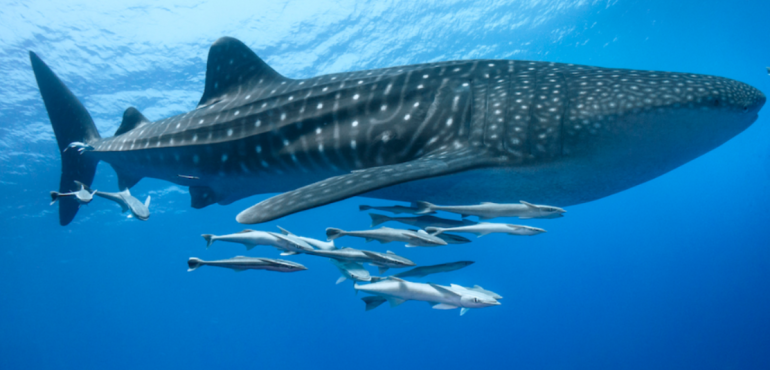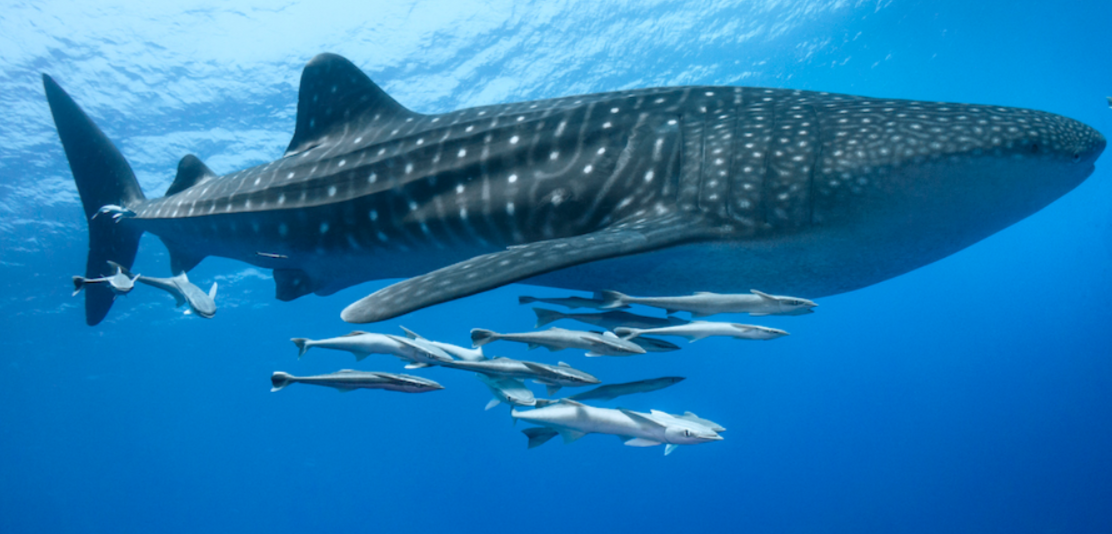
Whale shark in Ras Mohammed National Park. Image by Cinzia Osele Bismarck / Ocean Image Bank
By Elizabeth Claire Alberts via Mongabay
Migratory species that travel long distances in the ocean, including sharks, turtles and dolphins, face an unprecedented number of threats resulting from human actions. At the latest assembly of the Convention on the Conservation of Migratory Species of Wild Animals (CMS), representatives of governments made a series of decisions aimed at protecting migratory marine species, as well as their terrestrial, avian and freshwater counterparts. However, experts say more action needs to be urgently taken to stop their slide toward extinction.
The CMS treaty was created more than 40 years ago to conserve migratory species and their habitats on a global scale. Since then, representatives from the treaty’s 133 member states have met regularly to discuss actions to protect the species on Earth that regularly traverse national and international boundaries.
The 14th Meeting of the Conference of the Parties (COP14) took place in Samarkand, Uzbekistan, Feb. 12-17. During the assembly, parties agreed upon a number of measures to protect migratory species threatened with extinction. They added several new species to the convention’s appendices and made decisions to address the present and future threats to these species, such as the impacts of climate change and the prospect of deep-sea mining.
At the outset of the meeting, the CMS released a landmark report that found that populations of almost half of the nearly 1,200 species listed in the convention are declining, and that one in five are threatened with extinction. Research shows that fish are faring the worst, with nearly every fish species listed on the treaty inching closer to extinction. The report also found that about half of the world’s key biodiversity areas currently lack protection and that more than half of the key sites that CMS-listed species depend upon are experiencing high levels of human pressure. Overexploitation and habitat loss are the main threats to migratory species, the report revealed, while climate change, pollution and invasive species are also playing a role. The report also noted that about 400 migratory species aren’t currently listed in the convention, and therefore don’t benefit from the treaty’s protective measures.
 The CMS treaty was created more than 40 years ago to conserve migratory species and their habitats on a global scale. Freediver with Eagle Rays in the Bahamas. Image by Amanda Cotton / Ocean Image Bank.
The CMS treaty was created more than 40 years ago to conserve migratory species and their habitats on a global scale. Freediver with Eagle Rays in the Bahamas. Image by Amanda Cotton / Ocean Image Bank.
While the proceedings of COP14 related to species inhabiting different ecosystems across the world, many decisions focused on the protection of marine species. That emphasis “makes sense,” said Susan Lieberman, vice president of international policy at the Wildlife Conservation Society (WCS), since the “majority of our planet” is made up of ocean.
“There were a significant number of ocean issues discussed at the CMS COP because, of course, the oceans are incredibly important for migratory aquatic species and for migratory birds,” Lieberman, who attended COP14, told Mongabay.
Fourteen species, including many marine species, were newly listed in CMS appendices I and II. The first appendix dictates that listed species and their habitats must be protected, and tends to include species at high risk of extinction in all or most of their range. The second appendix comprises species with unfavorable conservation statuses and urges governments to work collaboratively to protect them. For instance, the critically endangered sand tiger shark (Carcharias taurus), Lahille’s bottlenose dolphin (Tursiops truncatus gephyreus), and several critically endangered ray species found in the Mediterranean, including the critically endangered blackchin guitarfish (Glaucostegus cemiculus), bull ray (Aetomylaeus bovinus) and Lusitanian cownose ray (Rhinoptera marginata), were among those recently listed in one or both of the convention’s appendices.
While the CMS doesn’t impose the same legally binding trade restrictions as the Convention on International Trade in Endangered Species of Wild Fauna and Flora (CITES), CMS Appendix I obliges member states to protect the listed species. However, since CMS doesn’t enforce compliance, there need to be more “actions or consequences for countries that do not fulfill their obligations under CMS,” Lieberman said.
Nicolas Entrup, director of international relations for the Swiss NGO OceanCare, said another notable development that came out of COP14 was the endorsement of scientifically defined areas deemed important for marine mammals and sharks and rays, which was incorporated into new management decisions. In the past, marine management decisions have often been “symbolic or popular” or dictated by policy, Entrup said, which makes this science-based approach noteworthy.
“That’s a scientific concept where scientists map the ocean just based on science and not about management interests,” Entrup, who also attended COP14, told Mongabay. “So that concept is enshrined in the convention now.
“When you endorse that concept, you understand that you have strong science that tells you to look into those areas and what the problems are,” he added.
 Fourteen species, including many marine species, were newly listed in CMS appendices I and II. Gray reef sharks at Fakarava atoll, French Polynesia. Image by Jayne Jenkins / Ocean Image Bank.
Fourteen species, including many marine species, were newly listed in CMS appendices I and II. Gray reef sharks at Fakarava atoll, French Polynesia. Image by Jayne Jenkins / Ocean Image Bank.
Entrup said this endorsement influenced other parts of the COP14 negotiations, such as a draft decision to reduce vessel strikes against marine megafauna. He said the decision’s special consideration of whale shark (Rhincodon typus) habitat along major shipping routes was “very positive progress for the convention.”
“So far, the focus on avoiding ship collisions has been on large whale species, which is also important for the conservation efforts,” he said. “But now, whale sharks have been introduced because they spend a lot of time on the surface area and are exposed to ship strikes this way.”
Representatives also adopted a resolution that urges CMS parties not to engage in or even to support deep-sea mining until “sufficient and robust scientific information has been obtained to make informed decisions as to whether deep-sea mining can be undertaken without significant damage to the marine environment and its unique fauna.”
While deep-sea mining has yet to begin anywhere in the world, several countries are looking to undertake such activities in the near future, both in their own national waters and in parts of high seas beyond national jurisdiction. While advocates of deep-sea mining say it’s a necessary venture to procure critical minerals for the development of technology vital to the transition away from fossil fuels, critics say it could cause irreparable harm to marine biodiversity and fisheries, and that the target minerals aren’t necessary for renewable energies. Any deep-sea mining that would take place in international waters would be governed by the U.N.-associated International Seabed Authority (ISA), which has many of the same member states as the CMS.
Entrup said the CMS resolution on deep-sea mining is a “progressive call” that urges both the ISA and governments not to rush into deep-sea mining.
“I think it’s an extraordinary result of the convention that such a strong wording has been adopted,” he said.
 Representatives also adopted a resolution that urges CMS parties not to engage in or even to support deep-sea mining. Sea turtle at sunset in Australia. Image by Jordan Robins / Ocean Image Bank.
Representatives also adopted a resolution that urges CMS parties not to engage in or even to support deep-sea mining. Sea turtle at sunset in Australia. Image by Jordan Robins / Ocean Image Bank.
Prior to the negotiations that led to this resolution, Michael Lodge, secretary-general of the ISA, sent a letter on Feb. 2 to Amy Fraenkel, the CMS executive director, saying he was “surprised” that the ISA was not consulted when the draft decision on deep-sea mining was being developed. Lodge also said he believed the document was “seriously flawed with significant mistakes revealing a lack of understanding of what deep sea mineral exploration and exploitation entails,” and that “almost half of the references cited are to materials published by anti-deep-seabed mining campaign groups which can lack objective scientific reference.”
Another achievement of COP14 was the adoption of an updated resolution on climate change, which urges parties to take action to mitigate and adapt to climate change and to consider the impacts of climate change on migratory species. The document also notes the “potential role of conserving migratory species in maintaining and enhancing the functionality of ecosystems important for mitigating and adapting to climate change.”
The resolution “includes new language recognizing the vital role of migratory species as the unsung heroes or as our allies in the fight against climate change,” Barbara Slee, an international policy expert at the U.S.-based International Fund for Animal Welfare, told Mongabay.
“We always stress the importance of species such as whales, elephants, sharks and their role in maintaining healthy ecosystems to absorb carbon and to help us fight climate change,” said Slee, who also attended COP14.
WCS’s Lieberman said that while COP14 had many successes, the CMS currently lacks the funding to put many of the decisions and actions into play.
“There’s a lot of goodwill there, but [there’s a] need for resources to do it,” she said.
Slee agreed that parties need more resources and to invest more effort into the conservation of species to ensure their survival. She also said that while the listing of new species in the convention is an achievement, the actual aim should be to “delist species because they’re doing well and they’re not threatened any longer with extinction.”
“The listing [of new species on CMS] shows that populations are doing really badly, and that we need to act upon what the science is telling us,” Slee said, “because we’re not going to have any more migratory species left if we continue like we do now.”
To read the original article click here.




 The CMS treaty was created more than 40 years ago to conserve migratory species and their habitats on a global scale. Freediver with Eagle Rays in the Bahamas. Image by Amanda Cotton / Ocean Image Bank.
The CMS treaty was created more than 40 years ago to conserve migratory species and their habitats on a global scale. Freediver with Eagle Rays in the Bahamas. Image by Amanda Cotton / Ocean Image Bank. Fourteen species, including many marine species, were newly listed in CMS appendices I and II. Gray reef sharks at Fakarava atoll, French Polynesia. Image by Jayne Jenkins / Ocean Image Bank.
Fourteen species, including many marine species, were newly listed in CMS appendices I and II. Gray reef sharks at Fakarava atoll, French Polynesia. Image by Jayne Jenkins / Ocean Image Bank. Representatives also adopted a resolution that urges CMS parties not to engage in or even to support deep-sea mining. Sea turtle at sunset in Australia. Image by Jordan Robins / Ocean Image Bank.
Representatives also adopted a resolution that urges CMS parties not to engage in or even to support deep-sea mining. Sea turtle at sunset in Australia. Image by Jordan Robins / Ocean Image Bank.






